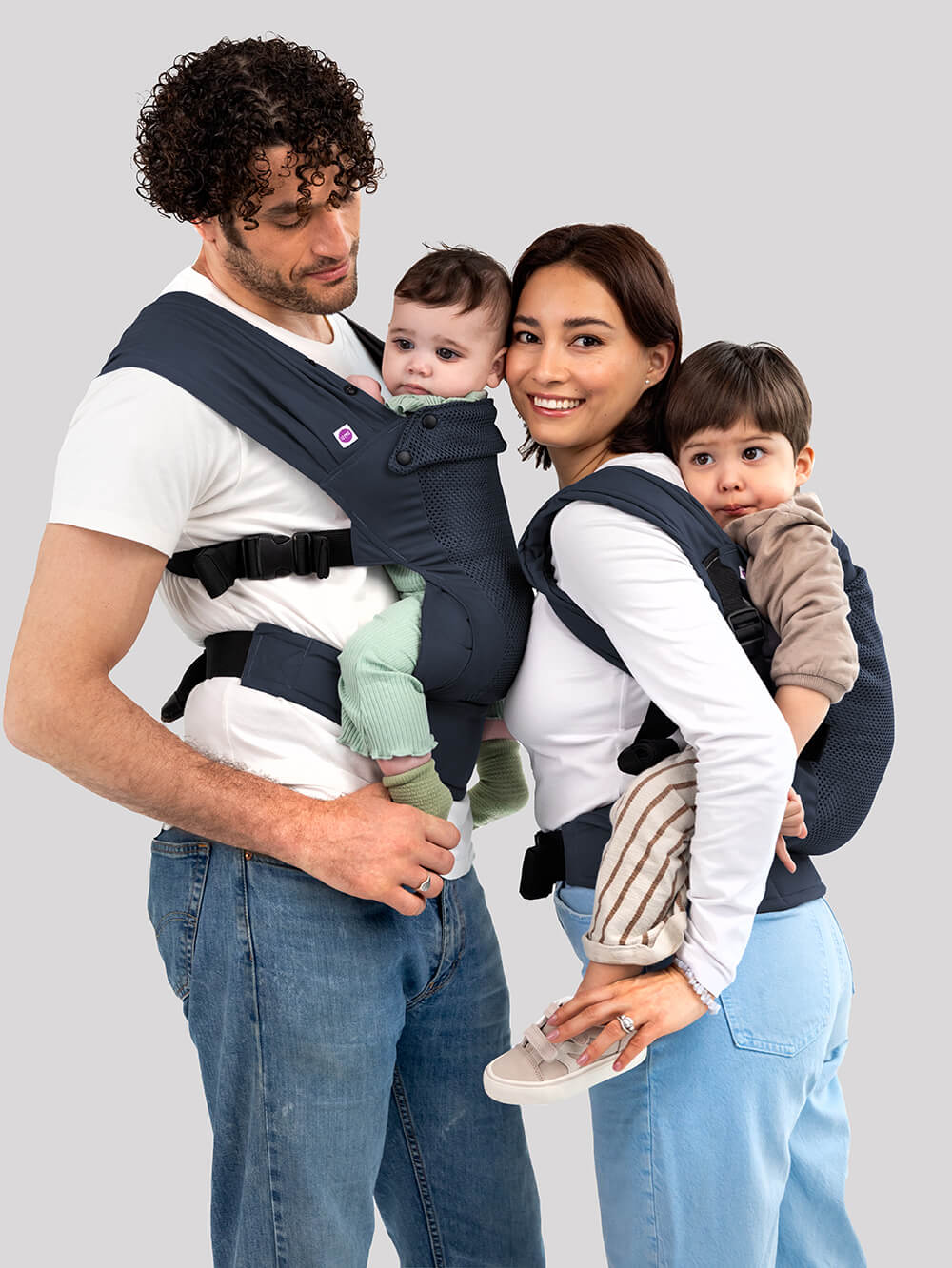Baby carriers may be a great tool to help you breastfeed on the go. An easy, lightweight carrier like the Izmi Baby Carrier can be much easier get to grips with, compared to a bulky, structured baby carrier. However, breastfeeding while using a baby carrier is not a hands-free activity and we do not generally recommend breastfeeding while wearing any baby carrier before your child is 4 months old.
Top 3 things you need to know about breastfeeding in a sling or baby carrier
1. Despite what you may have seen mum influencers doing on social media - or even in the instruction manuals of some baby carrier brands - there is no such thing as hands-free breastfeeding in any sling or carrier, especially with a newborn.
2. It's very important that you continue to monitor your baby the whole time they are feeding, and return them to a safe, hands-free carrying position as soon as they have finished actively feeding.
3. Babies who are under 4 months, born prematurely, or with any medical conditions are at all at higher risk because their airways are still developing and are easily obstructed. If in any doubt regarding the suitability of breastfeeding while wearing a wrap or carrier please do not attempt to do so until you have taken advice from an appropriately qualified professional.
How to breastfeed in a baby carrier
To breastfeed while wearing an Izmi Baby or Toddler Carrier it's easiest to feed with your baby sat/held upright. If your baby isn't able to sit unaided, you'll need to use at least one hand or arm to support them in an upright position. If your baby does not have excellent head and neck control, you'll also need to use one hand to help stabilise their head.
Before you try breastfeeding while wearing your Izmi Baby or Toddler Carrier
- Make sure your baby is able to latch comfortably in an upright position. If this position doesn't work for you or your baby right now, you may find it's possible once they are bigger and stronger. Many people find the upright position works better once their baby has excellent head control (4+ months) and is easiest once their baby can sit unaided (6+ months).
- Make sure you're wearing a top that can be pulled down, unbuttoned or easily lifted up for easy access.
- If you have any concerns or problems with breastfeeding, your baby needs extra assistance or care with latching, was premature or has an medical condition that could affect their ability to breathe freely while feeding please consult an appropriately qualified professional before attempting to breastfeed while wearing your Izmi Carrier (see the end of this article for recommendations).
To breastfeed while wearing your Izmi Carrier:
- Start in a front or hip carry position. For most people, when your baby is held in their normal high, tight, hands-free carrying position, they will be too high and too close to reach the breast.
- Loosen all the buckles slightly, then shuffle your baby down and to the side as needed until they are facing your breast.
- Make sure that the top of the carrier reaches no higher than the top of your baby's shoulders. Their head should be free to tilt back at all times so they can latch and unlatch themselves as needed. Nothing should restrict their head, or push their face into your body.
- Avoid covering or enclosing your baby's face or head with any fabric. It's really important that they can breathe freely through their nose at all times, and have a good supply of fresh air.
IMPORTANT SAFETY INFORMATION FOR BREASTFEEDING WITH ANY BABY CARRIER
- When you loosen your carrier it won't provide the same support to your baby's body or protection of their airways. You'll need to pay close attention to make sure they remain safe and able to breathe at all times.
- Babies who aren't able to sit by themselves - under around 6-8 months - may not be able to stay upright in a loosened carrier.
- Being in a slumped position makes it harder for a young baby to breathe; you'll need at least one hand to hold your little one in a safe upright position until they can do this on their own.
- You should always be able to see that there is nothing covering your baby's face or blocking their nose.
- All babies and toddlers have a greater risk of slipping or falling if the carrier is too loose.
As soon as they have finished feeding return them immediately to a safe position.
It is vital that once your child has finished actively feeding, even if they are asleep, you reposition them safely in your Izmi Carrier so they are held High, Tight and In Sight with their airways protected, in line with the TICKS guide for safe babywearing.
Getting one-to-one support to help you breastfeed with a baby carrier
If you'd like help with breastfeeding with a baby carrier - especially if your baby is under 4 months, born prematurely, or with any medical conditions we recommend getting 1:1 support from a trained and insured baby carrying consultant who has had additional training in breastfeeding; or a qualified lactation consultant who has additional baby carrying training.
More information on breastfeeding positioning and safety:
Breastfeeding: positioning and attachment (NHS)
Off to the best start: a guide to help you start breastfeeding (UNICEF/NHS)
Breastfeeding: attachment and positioning (NHS Norfolk)
Emily Rising, IBCLC Infant Feeding & Lactation Consultant, Babywearing Consultant and Creator of Izmi Baby
Hannah Wallace, Babywearing Consultant and Director, Izmi Baby




